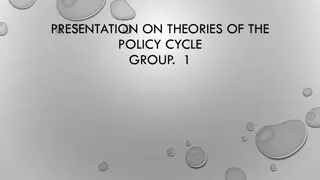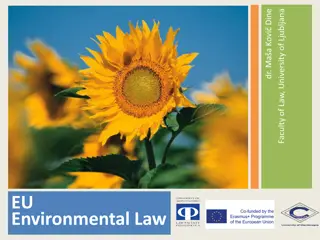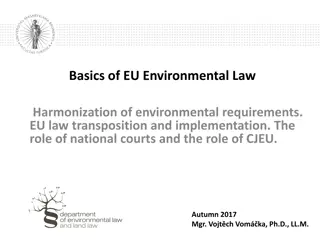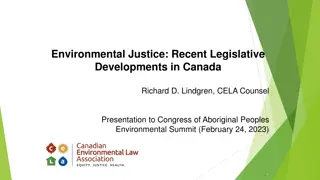
EU Environmental Law and Policy Analysis
This overview delves into the legal basis of EU environmental policies according to the Treaty on the Functioning of the European Union. It covers the integration of environmental protection requirements, Union policy objectives, precautionary principles, harmonization measures, cooperation with third countries, and more.
Download Presentation

Please find below an Image/Link to download the presentation.
The content on the website is provided AS IS for your information and personal use only. It may not be sold, licensed, or shared on other websites without obtaining consent from the author. If you encounter any issues during the download, it is possible that the publisher has removed the file from their server.
You are allowed to download the files provided on this website for personal or commercial use, subject to the condition that they are used lawfully. All files are the property of their respective owners.
The content on the website is provided AS IS for your information and personal use only. It may not be sold, licensed, or shared on other websites without obtaining consent from the author.
E N D
Presentation Transcript
JEAN MONNET MODULE DOHA COURSES ON EUROPEAN UNION LAW FALL 2021 DR. JON TRUBY
EU ENVIRONMENTAL LAW AND POLICY
Legal Basis: Treaty on the Functioning of the European Union Article 11: Environmental protection requirements must be integrated into the definition and implementation of the Union's policies and activities, in particular to promote sustainable development. Article 191: Union policy on the environment shall contribute to: preserving, protecting and improving the quality of the environment, protecting human health, prudent and rational utilisation of natural resources, promoting measures at international level to deal with regional or worldwide environmental problems, mainly combating climate change.
Legal Basis: Treaty on the Functioning of the European Union 2. Union policy on the environment shall aim at a high level of protection considering the diversity of situations in the various regions of the Union. It shall be based on the precautionary principle and on the principles that preventive action should be taken, that environmental damage should as a priority be rectified at source and that the polluter should pay. Harmonisation measures answering environmental protection requirements shall include, where appropriate, a safeguard clause allowing Member States to take provisional measures, for non-economic environmental reasons, subject to a procedure of inspection by the Union
Legal Basis: Treaty on the Functioning of the European Union 3. In preparing its policy on the environment, the Union shall take account of: available scientific and technical data, environmental conditions in the various regions of the Union, the potential benefits and costs of action or lack of action, the economic and social development of the Union as a whole and the balanced development of its regions.
Legal Basis: Treaty on the Functioning of the European Union Within their respective spheres of competence, the Union and the Member States shall cooperate with third countries and with the competent international organisations. The arrangements for Union cooperation may be the subject of agreements between the Union and the third parties concerned. The previous subparagraph shall be without prejudice to Member States' competence to negotiate in international bodies and to conclude international agreements.
Legal Basis: Treaty on the Functioning of the European Union Article 192: 1. The European Parliament and the Council, acting in accordance with the ordinary legislative procedure and after consulting the Economic and Social Committee and the Committee of the Regions, shall decide what action is to be taken by the Union in order to achieve the objectives referred to inArticle 191. By way of derogation from the decision-making procedure provided for in paragraph 1 and without prejudice to Article 114, the Council acting unanimously in accordance with a special consulting the European Parliament, the Economic and Social Committee and the Committee of the Regions, shall adopt: legislative procedure and after
Legal Basis: Treaty on the Functioning of the European Union (a) provisions primarily of a fiscal nature; b) measures affecting: town and country planning, quantitative management of water resources or affecting, directly or indirectly, the availability of those resources, land use, with the exception of waste management; (c) measures significantly affecting a Member State's choice between different energy sources and the general structure of its energy supply.
Legal Basis: Treaty on the Functioning of the European Union The Council, acting unanimously on a proposal from the Commission and after consulting the European Parliament, the Economic and Social Committee and the Committee of the Regions, may make the ordinary legislative procedure applicable to the matters referred to in the first subparagraph. 3. General action programmes setting out priority objectives to be attained shall be adopted by the European Parliament and the Council, acting in accordance with the ordinary legislative procedure and after consulting the Economic and Social Committee and the Committee of the Regions.
Legal Basis: Treaty on the Functioning of the European Union The measures necessary for the implementation of these programmes shall be adopted under the terms of paragraph 1 or 2, as the case may be. 4. Without prejudice to certain measures adopted by the Union, the Member States shall finance and implement the environment policy. 5. Without prejudice to the principle that the polluter should pay, if a measure based on the provisions of paragraph 1 involves costs deemed disproportionate for the public authorities of a Member State, such measure shall lay down appropriate provisions in the form of: temporary derogations, and/or financial support from the Cohesion Fund set up pursuant toArticle 177
Legal Basis: Treaty on the Functioning of the European Union Article 193: The protective measures adopted pursuant to Article 192 shall not prevent any Member State from maintaining or introducing more stringent protective measures. Such measures must be compatible with the Treaties. They shall be notified to the Commission.
Origins and Development Dates back to the European Council held in Paris in 1972, after the Stockholm Conference. The Single European Act of 1987 introduced a new Environment Title , which provided the first legal basis for a common environment policy. Subsequent treaty revisions strengthened the Community s commitment to environmental protection
Origins and Development The Treaty of Maastricht (1993) made the environment an official EU policy area, introduced the codecision procedure and made qualified majority voting in the Council the general rule. The Treaty of Amsterdam (1999) established the duty to integrate environmental protection into all EU sectoral policies with a view to promoting sustainable development. Combating climate change became a specific goal with the Treaty of Lisbon (2009), as did sustainable development in relations with third countries
General Principles EU environment policy rests on the principles of precaution, prevention and rectifying pollution at source, and on the polluter pays principle. Precautionary principle is a risk management tool that may be invoked when there is scientific uncertainty about a suspected risk to human health or the environment emanating from a certain action or policy. For instance, should doubts arise about the potentially harmful effects of a product, and should following an objective scientific evaluation uncertainty persist, instructions may be given to stop the distribution of the product or to remove it from the market.
General Principles The environmental damage to protected species or to natural habitats, water and soil. Operators of certain occupational activities such as the transport of dangerous substances, or of activities that imply discharge into waters, have to take preventive measures in case of an imminent threat to the environment. If damage has already occurred, they are obliged to take the appropriate measures to remedy it and pay for the costs. pays principle aims to prevent or otherwise remedy polluter
General Principles Furthermore, integrating environmental concerns into other EU policy areas has become an important concept in European politics since it first arose from an initiative of the European Council held in Cardiff in 1998. In recent years, environmental policy integration has made significant progress, for instance in the field of energy policy, as reflected in the parallel development of the EU s climate and energy package or in the Roadmap for moving to a competitive low-carbon economy by 2050.
The Environment Action Programmes Multiannual Environment Action Programmes (EAPs) setting out legislative proposals and goals for EU environment policy. EAP up to 2020 has nine priority objectives: e.g.: the protection of nature; stronger ecological resilience; sustainable, resource- efficient and low-carbon growth; and the fight against environment-related threats to health 2020 EAP stresses the need for better implementation of EU environment law, state-of-the-art science, investment, and integration of environmental aspects into other policies.
Horizontal Strategies In 2001, the EU introduced its Sustainable Development Strategy (SDS), thus complementing the earlier Lisbon Strategy for promoting growth and jobs with an environmental dimension. Renewed in 2006 to combine the internal and international dimensions of sustainable development, the revised EU SDS strives for the constant improvement of the quality of life by fostering prosperity, environmental protection and social cohesion. In line with these goals, the Europe 2020 strategy for growth aims at shaping smart, inclusive and sustainable growth .
International Environmental Cooperation The EU plays a key role in international environmental negotiations. It is a party to numerous global, regional or sub-regional environmental agreements on a wide range of issues, such as nature protection and biodiversity, climate change, and transboundary air or water pollution. The Union helped shape several major international agreements such E.g.: 2030 Agenda for Sustainable Development; Paris Agreement on Climate Change; Sendai Framework for Disaster Risk Reduction.
Environmental Impact Assessment and Public Participation Certain projects (private or public) that are likely to have significant effects on the environment. Equally, a range of public plans and programmes are subject to a similar process called a strategic environmental assessment (SEA). Environmental considerations are already integrated at the planning phase, and possible consequences are taken into account before a project is approved or authorised so as to ensure a high level of environmental protection.
Implementation, enforcement and monitoring EU environmental law has been built up since the 1970s. Several hundred directives, regulations and decisions are in force today in this field. The effectiveness of EU environmental policy is largely determined by its implementation at national, regional and local levels, and deficient application and enforcement remain an important issue. Monitoring is crucial both of the state of the environment and of the level of implementation of EU environmental law.
Implementation, enforcement and monitoring To counteract the wide disparity in the level of implementation among Member States, in 2001 the European Parliament and the Council adopted (non-binding) minimum standards for environmental inspections. In order to improve the enforcement of EU environmental law, Member States have to provide for effective, proportionate and dissuasive criminal sanctions for the most serious environmental offences. E.g.:the illegal emission or discharge of substances into the air, water or soil; illegal trade in wildlife; illegal trade in ozone-depleting substances; and illegal shipment or dumping of waste.
Implementation, enforcement and monitoring In May 2016, the Commission launched the Environmental Implementation Review. Its a new tool designed to help reach full implementation of EU environmental legislation, which goes hand in hand with its fitness check (Regulatory Fitness and Performance Programme REFIT) of monitoring and reporting obligations under existing EU legislation so as to make it simpler and less costly. To help policymakers take informed decisions and develop environmental legislation and policies, the EU also runs the European Earth Observation Programme (Copernicus), which addresses, among other concerns, land, marine, atmosphere and climate change






















